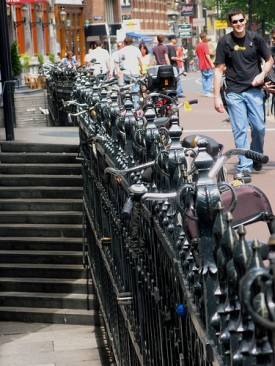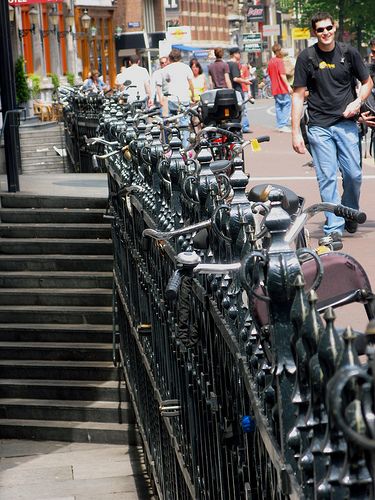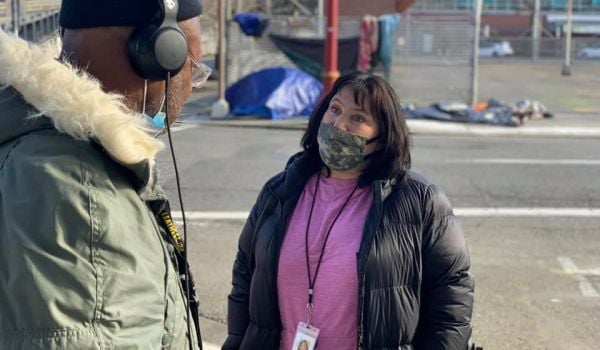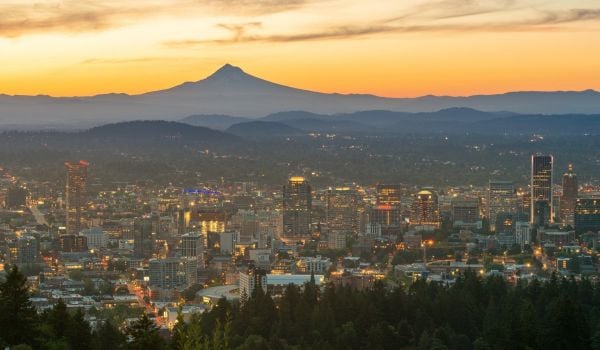David Alpert is the founder and editor of Greater Greater Washington, and a member of the Next American Vanguard. To read more of his work, visit his site here. Image: Bikes parked in Amsterdam, one of the world’s most bike-friendly cities. Image by kevindooley via flickr. 
Imagine visiting a city where the populace steadfastly refused to wear sweaters or coats despite a cold climate. You might tell your friends incredulous stories about how much people complain about being cold while ignoring an obvious solution. You might take pictures of the enormous three-story space heaters the city placed along its waterfront to let people enjoy the outdoors, and marvel at the ugliness and environmental waste of the practice. Why would the residents of this city endure such painful conditions at such cost to their city and their planet while ignoring such a simple alternative?
This sounds absurd, but scarcely more absurd than the way bicyclists talk about American cities. At Cities, Bicycles, and the Future of Getting Around, a panel discussion last week sponsored by the Brookings Institution, Congressman Earl Blumenauer posed what he called the “universalist bicycle mantra”: “How many people, right at this moment, are stuck in traffic on their way to ride a stationary bicycle in a health club?”
Why, indeed, would people endure stifling traffic just to hop on another form of transportation that goes nowhere? How is this not similar to walking around outside without a coat while complaining of the chill? What are people thinking? Children can’t get to school on their own, while childhood obesity skyrockets. Yet the evident solution to bicyclists, as simple as putting on the sweater, is simply to ride to school. Yet few do.
Musician David Byrne, author of The Bicycle Diaries, illustrated the absurdity every bicyclist sees in our cities through a slide show. He showed pictures of downtown Austin, Texas and Nashville, Tennessee, where giant highway overpasses soared above desolate landscapes below. He showed a streetscape from Houston, Texas, at 11:00 am, with only a single person visible across several blocks. “There was a group of people around the corner,” he said. “They were the smokers.” Some scenes could have depicted one of many American cities. “I’m not sure where this is,” he said, showing a picture of large parking lots separating the occasional tall building. “Maybe Indianapolis.” There’s no life visible, “unless you consider the car a form of life.”
Nevertheless, the average resident of these cities sees little unusual in these scenes. When driving, we see the broad brush of the buildings and the other cars; we tend not to notice a lack of pedestrians, especially when they are rare. When we travel on a bicycle, however, a city devoid of life seems utterly bizarre, and the populace’s blithe acceptance of this status quo even stranger.
Yet numerous early- to mid-twentieth century thinkers actively promoted this vision as an ideal. Byrne showed slides from Hugh Ferriss’s visions from the 1920s of giant skyscrapers amid lifeless voids, Frank Lloyd Wright’s Broadacre City of huge skyscrapers amid lifeless voids, Buckminster Fuller’s plan for Harlem of huge skyscrapers amid lifeless voids, and of course, the most well-known of all, Le Corbusier’s Ville Radieuse of… you guessed it. Corbusier’s plan was considered “enlightened,” Byrne noted, “because it had little green patches in the middle.”
Why can’t we just put on the coats? Why can’t people cycle in the numbers common in many European cities? Blumenauer and Byrne know why: bicycle infrastructure. We don’t have enough of it, at least outside Blumenauer’s hometown of Portland, Oregon. Its residents drive 30% less than in Houston, the Congressman said. They spend $2,500 less per year on transportation than the national average, and keep that money in the local economy instead of sending it overseas in oil payments. According to Blumenauer, Portland’s bicycle share has increased 400% for less than the cost of one mile of freeway.
New York City Transportation Commissioner Janette Sadik-Khan revealed one of the most vexing absurdities of all: federal rules that make it extremely difficult if not impossible to build good bicycle infrastructure. For a city to build a bicycle lane requires a detailed air quality conformity analysis and a long checklist of approvals, she explained, and requires the involvement of the state DOT. “There are no national street designs that accommodate best practices” in bicycle lane design, she added.
DC’s new protected, contraflow bike lane on 15th Street, NW is in no manual, added Sadik-Khan. Nor are bike boulevard markings, lanes painted with a color, or even bicycle signals. Wherever cities have built such projects, they’re in spite of accepted industry standards. “My favorite 5-letter word is PILOT,” she said; most of New York’s greatest successes in bicycle infrastructure have been officially pilot programs, like the protected lane through Midtown Manhattan which increased bicycling by 46% in that area.
In Sadik-Khan’s experience, getting approval to spend federal money on a project has typically been the most difficult part of the project, more even than the oft-vehement opposition from neighbors. Blumenauer, too, feels that opposition is not the major obstacle to progress, noting the over 180 members of the Congressional Bicycle Caucus. What are the obstacles, asked moderator Bruce Katz, Brookings Vice President and director of the Metropolitan Policy Program? Some people are “nervous about change,” Blumenauer noted, but worse is the “dysfunctionality of the system.”
Led by Sadik-Khan, the National Association of City Transportation Officials (NACTO) launched Cities for Cycling, an effort to create a new manual for street design that includes good bicycle infrastructure. They hope to make bicycle lanes, protected lanes, bike boulevards, bike signals and more official parts of a 21st-century version of the Manual of Uniform Traffic Control Devices, the bible of traffic engineers that currently enforces design around cars instead of people.
Blumenauer has another prescription: Political organizing. He called on those who support bicycle infrastructure to defend officials like DC Department of Transportation head Gabe Klein as he tries to build lanes like that on 15th Street or one on Pennsylvania Avenue near the Capitol that Blumenauer has been pushing for. If just five people email a council member about a bicycle lane, Klein added from the front of the audience, that can make an impact. That’s certainly the goal of the blogs around the nation pushing for bike lanes along with pedestrian-friendly streets and better transit, including my site in the Washington, DC area, Greater Greater Washington, and others around the country that collectively form the Streetsblog Network.
If a small group can make a difference, the next questioner hoped to: He pointed out that Brookings itself has no bicycle parking at its Massachusetts Avenue headquarters, and a sign on the door prohibits bicycles inside. A law in New York just took effect requiring office buildings with cargo elevators to accommodate bicycles if the companies leasing space want to let employees bring bicycles into the office; Sadik-Khan noted that safe, indoor bicycle parking is the leading obstacle for people to bike to work. For his part, Katz promised to look into the issue. Local cyclists will be keeping an eye on their progress.


_600_350_80_s_c1.jpg)













